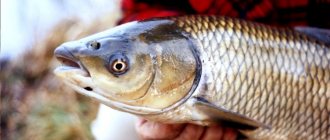Swordfish, or swordfish, are a valuable commercial fish. A species of ray-finned fish from the order Mackerelidae, the swordfish family, the only representative of its genus. One of the ten fastest fish in the world. Predatory habits and impressive size make the swordtail a dangerous inhabitant of the deep sea.
Have you tried swordfish?
- No 79%, 19 votes
19 votes 79%19 votes - 79% of all votes
- Yes 21%, 5 votes
5 votes 21%
5 votes - 21% of all votes
Total votes: 24
16.09.2019
×
You or from your IP have already voted.
What does a swordfish look like?
Many who read articles about the most aggressive and fast fish may wonder: what does such a fish look like, with a sword at the end? At least, it fully justifies its name: its muzzle has an unusual outgrowth in the mouth area, called the “sword”. A peculiar growth serves as a formidable weapon for the swordfish: with its help, it seems to impale prey on it, like on a spear, piercing its victim. This fish has no scales or pelvic fins, and its speed can outpace the fastest animal, the cheetah. Other characteristics of swordfish are:
| Swordfish | Characteristics of the species |
| View | Ray-finned |
| Squad | Perciformes |
| Adult size (length) | Up to 3 meters. Sometimes - up to 5 meters |
| Adult weight | More than half a ton |
| Distinctive feature | A long outgrowth at the end of the mouth (“sword”). Length - 1/3 of the body |
| Teeth | None. Only young animals have teeth |
| Scales | Absent |
| Tail shape | Crescent |
| Adult color | Brown. There are shades of dark blue |
| Eye color | Blue |
Attention: Swordfish is a very fast predator, capable of reaching a maximum speed of up to 130 kilometers per hour.
Description of the predator
The fish belongs to the ray-finned species from the order Perciformes. A large predator frightens with its threatening appearance and strength.
Another name for the predator is swordtail . An individual of this species grows up to three meters in length, but some reach 4.5 m. The approximate weight of one fish is 450 kg. The world record is a fish weighing 537 kg, caught on the shores of Chile.
The life expectancy of the predator is 10 years. Females are larger than males and live 5 years longer.
The swordfish looks like a sharp, dangerous weapon. Thanks to its threatening appearance, it received the appropriate name. The bone formations of the upper jaw, similar to a sword blade, reach 2 m in length. The flat growth is frightening in appearance. There is an opinion that with the help of sharp weapons on the body, the swordtail stuns other predators, but does not suffer itself. https://youtube.com/watch?v=4E9FOYNX8m0 The elongated snout, most of which extends behind the eyes, is the main weapon of swordfish. Predators pierce 3 cm thick metal without any problems. The impact force is over 4 tons. If the fish cannot get back out of the side, it will die.
Swordfish have no scales, but their body is well developed and takes on a streamlined shape. The fish has a tail in the shape of a moon. There are no fins on the belly, but they are present on the back, chest and sides. On the back there is a large front fin, starting from the back of the head. The rear one is located near the tail. This structure allows the swordfish to reach speeds of up to 130 km/h, which makes it faster than a cheetah.
The layers of fat act as a shock-absorbing spring. Thanks to this, an individual, when hitting an obstacle at a speed of more than 100 km/h, remains unharmed or suffers minor injuries.
The body of the sword fish is well developed and lacks scales.
The body of the individual is brown with a dark blue tint. The sides are cast in a metallic shade, and the belly is cast in a silvery tint. Blue eyes stand out against the general background. Young animals have stripes on their bodies that are lost over time.
Swordfish do not maintain their body temperature above water, but they have some peculiarity - they have a blood-warming organ around the eye . Blood flows to the brain stem and eyes, allowing fish to remain undetected at great depths in the ocean.
The fry grow teeth, but over time they lose them. Fish that do not reach 1 m in length have spines on their body. The gill muscles are like a mesh.
Character, behavior and lifestyle
It is impossible to hide from such fish. This fish will overtake anyone, even the fastest predator. She is an omnivore and eats everything, not even disdaining other predators. Swordfish are so aggressive that they sometimes even attack whales. Although scientists do not find an explanation for this behavior. It has such powerful armor that it can ram even the metal plating of boats. What can we say about the tree? Moreover, the fish itself does not suffer any serious injuries. Often ordinary fishermen and divers become victims of swordfish attacks. One of them was pierced through the chest by such a specimen, which caused the death of the unlucky fisherman.
Another interesting feature of this fish is that it received the title of the fastest inhabitant of the deep sea. In terms of speed, it is one of the 10 fastest sea predators. On the Internet you can find several videos with the same title: “Swordfish: rare footage.” It moves so quickly that it is almost impossible for an ordinary diver or fisherman to catch the moment.
The optimal temperature for fish to live is approximately 15 degrees Celsius. During the spawning period, the water temperature should reach at least 23 degrees Celsius. These fish are solitary by nature: some grow, some hunt. Seeing a school of swordfish is something out of fantasy. The only period when these fish come together is mating. And then, other couples keep a considerable distance from each other.
Among other interesting features of the swordfish, scientists note the following:
- Gill plates that perform two functions at once: the functions of breathing and movement, like a reactor. With the help of the special structure of the gill plates, the swordfish controls the speed of the water flow.
- Thermoregulation. Swordfish love warm waters. But when migrating, it lives in waters with low temperatures. In her body, near her eyeballs, there is a special organ that heats her blood and brain. Blood flowing to the eyeballs improves the quality of vision of the fish, which allows it to better see its prey and, accordingly, hunt. The temperature at which thermoregulation occurs is 15 degrees higher than the water temperature.
INTERESTING FACT: swordfish have a smooth body with a thick layer of fat. There are no scales on the body. The sword serves not only as a “ram,” but also as the fastest way to catch prey by piercing it through.
Teeth and jaws
The adult swordtail lacks teeth; they are observed only in young representatives. They lose them along with the spines on their body, which reach a length of 1 meter . The upper jaw acts as the main striking force and strikes the prey. It was possible to find squid and other fish representatives in the stomach of the swordfish. It is noteworthy that most of the prey eaten was damaged by the “sword” itself.
Where are swordfish found?
It is not difficult to answer the question: where are the fish that cut their victims with a sword like a knife? Swordfish like to live in warm waters. Before the migration period, they prefer to live in the waters of the Atlantic, Indian and Pacific Oceans. When the migration period begins, the swordfish swims beyond the Azov, Black, Mediterranean and Marmara seas.
Where do swordtails live?
The Pacific, Indian and Atlantic oceans are where swordtails can be found. That is, they prefer warm waters.
During mass feeding migrations, these predators can also be found in cold waters with a temperature of about 15 degrees, but for reproduction they need an ambient temperature of about 23 degrees.
Individual swordfish usually do not swim to the shore, living at depths of 600-800 meters (they can descend to a maximum of 2800 meters). These predators are loners, they do not gather in packs and keep a distance of 10-100 meters from each other.
Population and species status
Even though, according to the latest statistics from scientists, marine life is thinning out (the latest figures are 40%), swordfish stably maintains its population. It is so popular among fishermen that several years ago there was an oversupply of this fish on store shelves. Since it is impossible to catch it with ordinary fishing rods, most fishermen do it using deep-sea or drift nets.
This fish is considered one of the most valuable and commercial fish. World catches of swordfish amounted to 100 thousand tons per year. Despite its aggressive lifestyle, this fish is hunted by other large marine predators: sharks and killer whales. But the greatest danger is posed by the person who catches it for its delicious meat. But here, too, nature took care of this fish: one adult, sexually mature female can lay about 15 million eggs at a time. This allows us to maintain a stable population of the species.
Predation and lifespan
Adult swordtails are at the top of the food chain and are rarely preyed upon by other animals. Sometimes they become prey for killer whales and blue-gray sharks. But young individuals are preyed on by a variety of predators, including tuna, bigheads, marlin, sailfish and sharks.
Swordfish live for about 9 years, but can live up to 15 years. Females live longer than males.
How do they reproduce?
These fish prefer to hunt and live alone. And only during the spawning period do they pair up. As soon as individuals reach the age of 5-6 years, they undergo puberty and can already spawn. The length of an adult during this period reaches 170 cm. During the spawning period, pairs wash ashore. An adult female is capable of laying several million eggs at a time. The larger the female, the more eggs she can lay. But for spawning to be comfortable, the water temperature must be warm: at least 23 degrees. Spawning occurs directly into the water, which already contains the male’s seminal fluid. Fertilization occurs quickly.
Spawning periods depend on the habitat of the fish:
- The waters of the Atlantic Ocean - all year round.
- Pacific Ocean waters (at an optimal water temperature of 23 degrees Celsius) - in the spring or summer season.
- Indian Ocean, eastern Atlantic Ocean - from November to February.
Swordfish eggs reach a size of up to 1.8 mm and mature in approximately 3 days. After maturation, the fry are born. They have a microscopic body, but they already have rough scales and rather prickly spines. At first, the young live on the surface of the water and feed on zooplankton. But since this species grows very quickly, it requires a large amount of food, for which the fry descends to great depths. The most important distinctive feature of swordfish appears when the fry reaches a length of 8 mm. It is then that he begins to turn from a fry into a formidable predator, and begins to hunt small fish.
When the young predator is one year old, it reaches a length of just over half a meter. By this age, he looks like an adult. While the fish is growing, there are transverse stripes on its body that gradually disappear. When the fish reaches the age of 3 years, it moves to tropical waters.
ATTENTION: the high fertility of the species allows the fish not to reduce the population level.
What does it eat?
This species is a formidable and predatory fish. Swordfish eat anything. Its diet is huge: from small plankton (with the growth of fry) to large fish. She can fight and win even with a small mako (blue-gray shark). Developing speeds of up to 140 kilometers per hour, swordfish hunt both small and larger organisms. For this purpose, she sometimes even attacks whales, although more due to her character traits. After all, an adult whale is capable of destroying a self-confident fish in one fell swoop. The standard fish diet consists of:
- Mackerel.
- Mackerel.
- Herring.
- Sea bass.
- Crustaceans.
- Tuna.
- And even small squids.
She seems to cut her prey in half. Analysis of the stomach contents showed that it contained pieces of prey. Often fish swallow food whole.
Natural enemies of swordfish
There are practically no natural enemies found in the depths of the sea. This fish can be compared with the birds from Angry Birds in terms of aggression. No one dares to attack a swordfish except an orca or a large shark. But only a young and inexperienced individual who has not yet learned to hunt can become a victim. An adult five-meter individual can easily defeat a killer whale or a shark by piercing them with its sharp harpoon.
But the most dangerous enemy of this fish is the person who catches it with nets. The meat is considered a delicacy, not inferior in nutritional value to sea bass and tuna. The tender pink or white meat tastes like pork, but it contains a small amount of fat. The color of the meat depends on the diet and can be:
- Red.
- White.
- Orange (when feeding on shrimp).
Eating
Swordfish meat is boneless and is considered a delicacy for which sailors risk themselves when going out into the ocean. The color of the meat can be different, and it depends on what food the individual primarily consumed throughout its life. If the diet was dominated by shrimp, it will turn orange. White meat is most in demand. The consumption of this fish is contraindicated during pregnancy and childhood.
Useful properties and composition
This meat is considered dietary, containing no more than 140 kcal per 100 grams. It contains many vitamins and antioxidants that can help improve the functioning of the body. More detailed content of vitamins and microelements is given in the table:
| Vitamins and microelements | Benefits for the body |
| Protein | Strengthens and improves immunity |
| Omega-3 | Controls cholesterol levels, cellular rejuvenation |
| Kholin | Good for the liver |
| Vitamin B | Accelerates metabolism, normalizes the functioning of the central nervous system |
| Phosphorus | Takes part in strengthening bone tissue |
| Vitamin E | Improves blood cell quality |
| Vitamin D | Strengthens bones |
| RR | Improves metabolism, gastrointestinal tract, central nervous system, skin elasticity |
| Selenium | Slows down the aging process |
| Potassium | Regulates water and acid balance |
Interesting features, tips
It is interesting that due to the unusual method of movement of the fish, individual parts of its flesh have different calorie content ( 190 kcal per 100 g versus the usual 144 kcal ).
During migration, the swordtail is able to cover up to 34 km in a day and dive to a depth of over 800 meters.
The taste of fish depends on age and weight. The latter is determined based on size. Really good meat comes from fish whose size exceeds 0.5 meters and weighs 30 kg . When choosing fish, preference is given to individuals with pink meat. Pulp that is too light is a sign of low quality product.
When planning to enjoy swordtail meat in an exotic location, it is important to remember safety precautions. Even very high-quality food, but improperly prepared food, can cause serious poisoning. Swordfish dishes improve the functioning of the entire body, but, as mentioned above, this fish should not be included in the daily diet.
Harm to marine life and humans
The only serious harm that a swordfish can cause is to eat its prey. Due to its character, this fish attacks everything that moves. Divers, divers and even small schooners can become accidental victims. A sharp growth can easily pierce even the metal on a boat, which can cause the boat to flood and cause further death. But sometimes accidents happen accidentally, due to the fish moving too fast.
If we talk about harm to humans, we mean consumption. Sometimes swordfish is consumed raw. But there is a danger of infection by numerous parasites that live in fish.
INTERESTING FACT: in order to get rid of external parasites, individuals often jump out of the water several meters in height.
Taxonomy and etymology[edit]
The swordfish is named for its pointed, flat, sword-like beak. Species name, Xiphias gladius
, comes from Greek ξιφίας (
xiphias
, "swordfish"), itself from ξίφος (
xiphos
, "sword") and from Latin gladius ("sword"). [4] This makes it similar in appearance to other marine fish such as marlin, but when viewed their physiology is very different and they are members of different families. [6]
Several extinct genera are known, such as Xiphiorhynchus
large size and
Aglyptorhynchus
.
[7] Unlike modern taxa, they have equally long mandibles. [ citation needed
]
Use in cooking
This fish is considered a delicacy. Its taste is gentle and noble, reminiscent of pork. But the longer the fish is thermally processed, the less vitamins and benefits it contains. Most often it is red meat that is valued. Gourmets claim that white meat indicates the youth of the fish or its staleness. The ideal weight for an adult is at least 30 kg. A lower weight indicates that the fish is still young and its meat is not yet “ripe”.
This fish can be prepared in all different ways:
- Cooking.
- Extinguishing.
- Baking.
- Frying.
- Grill.
ATTENTION: fried fish is not recommended for consumption by people suffering from stomach and gastrointestinal diseases. Also, due to the fairly high mercury content, meat is not recommended for pregnant women and small children.
Save status[edit]
| This section requires additional links for verification . |
Swordfish on deck during longline work
In 1998, the U.S. Natural Resources Defense Council and SeaWeb hired Fenton Communications to run an advertising campaign to promote their claim that the swordfish population was endangered due to its popularity as a restaurant snack. [28]
The resulting "Give Swordfish a Break" promotion was extremely successful, with 750 prominent US chefs agreeing to remove North Atlantic swordfish from their menus and convincing many supermarkets and consumers across the country.
The advertising campaign was repeated by national media in hundreds of print and radio broadcasts, as well as extensive regional coverage. He has received the Silver Anvil award from the Public Relations Society of America, as well as an award from Time
for the five best environmental stories of 1998.
The US National Marine Fisheries Service subsequently proposed a swordfish protection plan that included campaign policy proposals. Then-US President Bill Clinton called for a ban on the sale and import of swordfish, and in a landmark decision by the federal government, 132,670 square miles (343,600 km2) of the Atlantic Ocean were off-limits to fishing as recommended by sponsors.
In the North Atlantic, swordfish stocks have fully recovered and biomass estimates are now 5% above target. [29] No reliable assessments of swordfish stocks have been made in the Northwest Pacific or South Atlantic, and data on the status of stocks in these regions is not available. These stocks are considered unknown and are of moderate conservation concern. Southwest Pacific stocks are of moderate concern due to model uncertainty, increasing catches, and declining catches per unit effort. Overfishing is likely to occur in the Indian Ocean, and fishing mortality exceeds the maximum recommended level in the Mediterranean Sea, so these stocks are considered to be of major conservation concern. [thirty]
In 2010, Greenpeace International added swordfish to its seafood red list. [31]
Commercial significance
The annual catch is more than 100 thousand tons of individuals. More than 30 countries catch it on an industrial scale. The largest catches occurred in the eastern and northwestern waters of the Pacific Ocean, the western waters of the Indian Ocean and the Mediterranean Sea.
In terms of its popularity among commercial fish, swordfish is in no way inferior to tuna or sea bass. Its meat may be expensive, but it is completely worth the price. The meat has a very delicate texture and practically no small bones in the flesh. And the characteristic “fishy” smell is completely absent. Often, no matter how valuable the fish is, many people do not want to cook and clean it. This is due to several factors:
- The fish is slippery due to the presence of scales.
- There are a lot of bones, which makes it difficult to absorb food.
- The smell completely discourages the desire to taste this fish.
This fish lacks all these factors. And even though catching it is almost impossible, many fishermen still manage to do it. Swordfish are an excellent trophy for a fisherman. Even ide will not cause such delight as swordfish. Of course: an adult specimen reaches 5 meters in length and weighs more than half a ton! Such fish is not only a valuable trophy, but also an excellent opportunity to earn extra money, since its meat is very expensive. Well, the excellent taste of the meat is an added bonus.
Recreational fishing[edit]
| This section requires additional links for verification . |
Recreational fishing has developed a specialty called swordfishing. Due to bans on longline fishing in many areas of the coast, swordfish populations are showing signs of recovery from overfishing caused by longline fishing along the coast.
Various methods are used to catch swordfish, but the most common method is deep fishing, since swordfish spend most of the daylight hours very deep, in the deep scattering layer. The boat is allowed to drift to obtain a more natural bait. Swordfishing requires durable rods and reels as swordfish can get quite large and it is not uncommon to have to use five pounds or more of weight to get the bait deep enough during the day, usually up to 1,500 feet. [23]Night fishing baits are usually caught at much shallower depths, often less than 90 meters (300 ft). Standard baits are whole mackerel, herring, mullet, mackerel or squid; You can also use live bait. Imitation squid and other fish-imitating lures can also be used, and specialized lures made specifically for swordfishing often have battery-powered or glowing lights. Even lures are usually presented using glow sticks or special battery-powered lights for deep-sea use.











